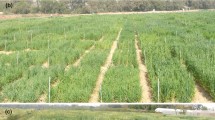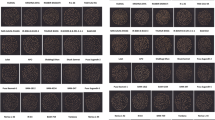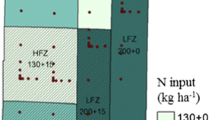Abstract
The grain protein concentration (GPC) and yield are intimately and negatively correlated in wheat. However, how carbon (C) and nitrogen (N) supplies influence the wheat growth that underlies yield and quality formation has not been fully explored. Two wheat varieties with high GPCs (ZM578) and low GPCs (LY502) were grown under low and optimum N supplies in the field, and their growth, yields, and GPCs were closely investigated. The grain yield and total N uptake of the wheat variety ZM578 were comparable to those of LY502, but the GPCs increased by 12.4–16.1% on average. Compared with LY502, ZM578 had lower maximum stem numbers but similar spike numbers at maturity due to a lower rate of tiller mortality, which partly contributed to its grain yield. The grain N and C assimilation rates strongly and linearly correlated with each other, while steeper slopes were observed for the optimum- vs. low-N treatments, as well as for the high- vs. low-GPC treatments. Similarly, the C to N ratios in the develo** grains of ZM578 were lower than those in the develo** grains of LY502, regardless of N availability, which indicated that more N was transported to the grains per unit C in high-GPC ZM578. The random forest model revealed that the grain N uptake and leaf senescence (SPAD during grain filling) were the major controlling factors of yields and GPCs in cultivar ZM578. Overall, this study demonstrated that high yields and high quality can be simultaneously achieved by optimizing N management and selecting superior varieties.








Similar content being viewed by others
References
Alzueta, I., Abeledo, L. G., Mignone, C. M., & Miralles, D. J. (2012). Differences between wheat and barley in leaf and tillering coordination under contrasting nitrogen and sulfur conditions. European Journal of Agronomy, 41, 92–102.
Assuero, S. G., & Tognetti, J. A. (2010). Tillering regulation by endogenous and environmental factors and its agricultural management. The Americas Journal of Plant Science and Biotechnology, 4, 35–48.
Bogard, M., Allard, V., Brancourt-Hulmel, M., Heumez, E., Machet, J., Jeuffroy, M., Gate, P., Martre, P., & Gouis, J. L. (2010). Deviation from the grain protein concentration–grain yield negative relationship is highly correlated to postanthesis N uptake in winter wheat. Journal of Experimental Botany, 61, 4303–4312.
Cazetta, J. O., Seebauer, J. R., & Below, F. E. (1999). Sucrose and nitrogen supplies regulate growth of maize kernels. Annals of Botany, 84, 747–754.
Chanda, S. V., & Singh, Y. D. (2002). Estimation of leaf area in wheat using linear measurements. Plant Breeding and seed Science, 46, 75–79.
Chen, X., Zhang, F., Romheld, V., Horlacher, D., Schulz, R., BöningZilkens, M., Claupein, W. (2006). Synchronizing N supply from soil and fertilizer and N demand of winter wheat by an improved Nmin method. Nutrient Cycling in Agroecosystems, 74, 91–98.
Davidson, D. J., & Chevalier, P. M. (1990). Preanthesis tiller mortality in spring wheat. Crop Science, 30, 832–836.
Dreccer, M. F. (2012). Nitrogen use at the leaf and canopy level. Journal of Crop Improvement, 15, 97–125.
Ehdaie, B., Alloush, G. A., & Waines, J. G. (2008). Genotypic variation in linear rate of grain growth and contribution of stem reserves to grain yield in wheat. Field Crops Research, 106, 34–43.
Engstrom, L., & Bergkvist, G. (2009). Effects of three N strategies on tillering and yield of low shoot density winter wheat. Acta Agriculturae Scandinavica Section B–Soil and Plant Science, 59, 536–543.
Feil, B. (1997). The inverse yield–protein relationship in cereals: Possibilities and limitations for genetically improving the grain protein yield. Trends in Agronomy, 1, 103–119.
Gaju, O., Allard, V., Martre, P., Snape, J. W., Heumez, E., LeGouis, J., Moreau, D., Bogard, M., Griffiths, S., Orord, S., Hubbart, S., & Foulkers, M. J. (2011). Identification of traits to improve the nitrogen-use efficiency of wheat genotypes. Field Crops Research, 123, 13–152.
Hirel, B., Gouis, J. L., Ney, B., & Gallais, A. (2007). The challenge of improving nitrogen use efficiency in crop plants: Towards a more central role for genetic variability and quantitative genetics within integrated approaches. Journal of Experimental Botany, 58, 2369–2387.
Huang, X., Wang, C. Y., Hou, J. F., Du, C. Y., Liu, S. J., Kang, J., Lu, H. F., **e, Y. X., Guo, T. C., & Ma, D. Y. (2020). Coordination of carbon and nitrogen accumulation and translocation of winter wheat plant to improve grain yield and processing quality. Scientific Reports, 10, 10340.
Kichey, T., Hirel, B., Heumez, E., Dubois, F., & Gouis, J. L. (2007). In winter wheat (Triticum aestivum L.), post-anthesis nitrogen uptake and remobilisation to the grain correlates with agronomic traits and nitrogen physiological markers. Field Crops Research, 102, 22–32.
Kong, L. G., ** grain in wheat (Triticum aestivum L). Field Crops Research, 196, 134–144.
Lawlor, D. W. (2002). Carbon and nitrogen assimilation in relation to yield: Mechanisms are the key to understanding production systems. Journal of Experimental Botany, 53, 773–787.
Lohaus, G., Büker, M., Mann, M., & Heldt, S. (1998). Transport of amino acids with special emphasis on the synthesis and transport of asparagine in the Illinois Low Protein and Illinois High Protein strains of maize. Planta, 205, 181–188.
Lu, D., Lu, F., Yan, P., Cui, Z., & Chen, X. (2014). Elucidating population establishment associated with N management and cultivars for wheat production in China. Field Crops Research, 163, 81–89.
Lynch, J. P., Doyle, D., Mcauley, S., Mchardy, F., Danneels, Q., Black, L. C., & Spink, J. (2017). The impact of variation in grain number and individual grain weight on winter wheat yield in the high yield potential environment of Ireland. European Journal of Agronomy, 87, 40–49.
Ma, D. Y., Guo, T. C., Wang, Z. J., Wang, C. Y., Zhu, Y. J., & Wang, Y. H. (2009). Influence of nitrogen fertilizer application rate on winter wheat (Triticum aestivum L.) flour quality and Chinese noodle quality. Journal of the Science of Food and Agriculture, 89, 1213–1220.
Masoni, A., Ercoli, L., Mariotti, M., & Arduini, I. (2007). Post-anthesis accumulation and remobilization of dry matter, nitrogen and phosphorus in durum wheat as affected by soil type. European Journal of Agronomy, 26, 179–186.
Nerson, H. (1980). Effects of population-density and number of ears on wheat yield and its components. Field Crops Research, 3, 225–234.
Ning, P., Maw, M. J. W., Yang, L., & Fritschi, F. B. (2021). Carbon accumulation in kernels of low-nitrogen maize is not limited by carbon availability but by an imbalance of carbon and nitrogen assimilates. Journal of Plant Nutrition and Soil Science, 184, 217–226.
Pan, J., Cui, K., Wei, D., Huang, J., **ang, J., & Nie, L. (2011). Relationships of non-structural carbohydrates accumulation and translocation with yield formation in rice recombinant inbred lines under two nitrogen levels. Physiologia Plantarum, 141, 321–331.
Peng, S., Khush, G. S., Virk, P., Tang, Q.,&Zou, Y. (2008). Progress in ideotype breeding to increase rice yield potential. Field Crops Research, 108, 32–38.
Schnyder, H. (1993). The role of carbohydrate storage and redistribution in the source-sink relations of wheat and barley during grain filling-a review. New Phytologist, 123, 233–245.
Seebauer, J. R., Singletary, G. W., Krumpelman, P. M., Ruffo, M. L., & Below, F. E. (2010). Relationship of source and sink in determining kernel composition of maize[J]. Journal of Experimental Botany, 61, 511–519.
Simmonds, N. (1995). The relation between yield and protein in cereal grain. Journal of the Science of Food and Agriculture, 67, 309–315.
Sosulski, F. W., & Imafidon, G. I. (1990). Amino acid composition and nitrogen-to-protein conversion factors for animal and plant foods. Journal of Agricultural and Food Chemistry, 38, 1351–1356.
Tian, G. L., Gao, L. M., Kong, Y. L., Hu, X. Y., **e, K. L., Zhang, R. Q., Ling, N., Shen, Q. R., & Guo, S. W. (2017). Improving rice population productivity by reducing nitrogen rate and increasing plant density. Plos One, 12, e0182310.
**ong, F., Yu, X., Zhou, L., & Wang, Z. (2014). Effect of nitrogen fertilizer on distribution of starch granules in different regions of wheat endosperm. The Crop Journal, 2, 46–54.
Xu, Z., Yu, Z., & Zhao, J. (2013). Theory and application for the promotion of wheat production in China: Past, present and future. Journal of the Science of Food and Agriculture, 93, 2339–2350.
Yang, D. Q., Cai, T., Luo, Y. L., & Wang, Z. L. (2019). Optimizing plant density and nitrogen application to manipulate tiller growth and increase grain yield and nitrogen-use efficiency in winter wheat. Peer J 7, e6484.
Ye, Y., Wang, G., Huang, Y., Zhu, Y., Meng, Q., Chen, X., & Cui, Z. (2011). Understanding physiological processes associated with yield-trait relationships in modern wheat varieties. Field Crops Research, 124, 316–322.
Yu, X., Wang, L., Ran, L., Chen, X., Sheng, J., Yang, Y., Wu, Y., Chen, G., & **ong, F. (2020). New insights into the mechanism of storage protein biosynthesis in wheat caryopsis under different nitrogen levels. Protoplasma, 257, 1289–1308.
Yue, S., Meng, Q., Zhao, R., Li, F., Chen, X., Zhang, F., & Cui, Z. (2012). Critical nitrogen dilution curve for optimizing nitrogen management of winter wheat production in the North China Plain. Agronomy Journal, 104, 523–529.
Zhang, L., He, X., Liang, Z., Zhang, W., Zou, C., & Chen, X. (2020). Tiller development affected by nitrogen fertilization in a high-yielding wheat production system. Crop Science, 60, 1034–1047.
Zhang, G., Liu, S., Dong, Y., Liao, Y., & Han, J. (2022). A nitrogen fertilizer strategy for simultaneously increasing wheat grain yield and protein content: Mixed application of controlled-release urea and normal urea. Field Crops Research, 277, 108405.
Acknowledgements
This research was funded by the [National Key Research and Development Program of China] (2021YFD1901005), and the [Chinese Universities Scientific Fund] (2023TC150).
Author information
Authors and Affiliations
Corresponding author
Ethics declarations
The authors declare that they have no known competing financial interests or personal relationships that could have appeared to influence the work reported in this paper. No potential conflict of interest was reported by the authors.
Additional information
Publisher’s Note
Springer Nature remains neutral with regard to jurisdictional claims in published maps and institutional affiliations.
Rights and permissions
Springer Nature or its licensor (e.g. a society or other partner) holds exclusive rights to this article under a publishing agreement with the author(s) or other rightsholder(s); author self-archiving of the accepted manuscript version of this article is solely governed by the terms of such publishing agreement and applicable law.
Received:
Accepted:
Published:
DOI: https://doi.org/10.1007/s42106-024-00298-z




